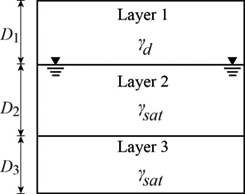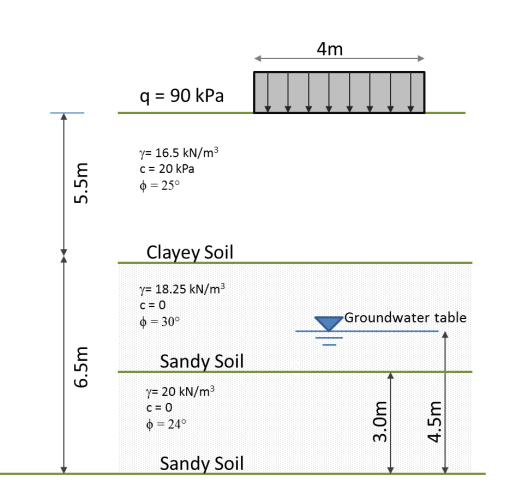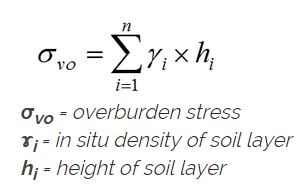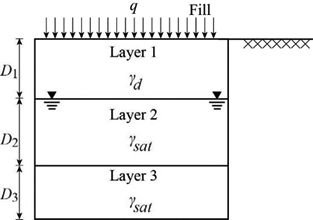How to Calculate Overburden Pressure of Soil
The effective overburden pressure at a given depth is the total pressure minus the pore water pressure. What is overburden soil pressure.

Definition Of Effective Overburden Pressure Chegg Com
The engineers taking the density log measurement will emit gamma rays into the bore in order to establish the density expressed as kilograms per cube meter of the sample.

. Overburden pressure is the pressure on the rock from the weight of the rock and earth above the formation. The term effective means that the submerged unit weight of soil is used when calculating the pressure below the groundwater level. 01 to obtain the overburden pressure.
Draw out all pressure profiles in a neat manner using a ruler. What is net allowable soil bearing pressure. The porosity permeability and compressibility are reduced.
If the materials making up a specific area as well as the porosity and depths at which those materials are found is known a few calculations can establish an approximation. The total load due to soil overburden is calculated as follows. The load is directly transferred through the particles contact only.
U h γ w γ w density of water 624 lbcf. Overburden stress can cause errors or drift in CPT measurements creating the need for correction factors in deeper test depths and soft or fine-grained soils. If your still having trouble with the bulk density concept.
Preconsolidation pressure is the maximum effective vertical overburden stress that a particular soil sample has sustained in the past. Density logs can be used to determine the overburden stress. Pick up any soils book and they will tell you how to calculate overburden pressure.
In the example above a soil overburden load of 05ksf is applied to a 15x15 slab with four rectangular 15x15 pedestals. For instance assume that a soil has a total unit weight γ of 120 pcf and the groundwater. Ultimate gross bearing capacity qgross- It is the sum of ultimate net bearing capacity and the overburden pressure above the footing base.
Know where the water table is and subtract off the pressure due to the weight of water above your point effective pressure. The total overburden pressure at a given depth is obtained from summing the product of the total unit weight times the layer thickness versus depthThe effective overburden pressure at a given depth is the total pressure minus the pore water pressure. Safe net bearing capacity.
The soil overburden pressure is multiplied by the area of the slab and is scaled to reduce the magnitude by the areas of and pedestals and stem walls. When the overburden pressure exceeds the fluid pressure in the pore space the formation is compacted. Alternative names for the preconsolidation pressure are preconsolidation stress pre-compression stress.
This factor was defined as. From the figure above it is clear that the overburden stress at a depth the datum point is the sum of the pressure caused by the fluid column and the pressure caused by the rock fluid-grain mixtureIt is important to note that we use bulk density when calculating the pressure caused by the rock column NOT the grain density. Simplistically Total pressure unit weight x depth to consideration adjust unit weight and thicknesses to stratigraphy.
In this case for the sake of sizing of footing you need to to deduct weight of over burden soil so that so may find out net bearing capacity available to. The soil can bear 125 tsf of total pressure which includes EXTERNALAPPLIED pressure caused by load of above structure including load of footing and pressure caused by existing soil. Overburden pressure is the vertical pressure applied on a layer of rock from the rock and soil above it.
As a result the porosity permeability and compressibility are reduced. Overburden pressure is sometimes called overburden stress as well. A Calculate the total overburden effective stress and pore pressure distribution for the soil profile below.
What Is Overburden Soil Pressure. Pressure is force magnitude applied over an areaOverburden pressure is a geology term that denotes the pressure caused by the weight of the overlying layers of material at a specific depth under the earths surface. Overburden pressure is the vertical pressure applied on a layer of rock from the rock and soil above it.
Considering this How do you calculate overburden. Overburden pressure is also called lithostatic pressure or vertical stress. Neglect the surcharge for this analysis.
An overburden pressure is the pressure on a rock that is caused by the weight of the rock and earth above it. How do you calculate overburden pressure. The purpose of the soil survey is to assist with the identification and salvage of all suitable topsoil material.
1 where CRRσ vcα0 and CRRσ vc1α0 are the cyclic resistance ratios for a static shear stress. Overburden stress also called vertical stress or overburden pressure is the pressure imposed on a layer of soil by the weight of the layers on top of it. If a density log is not available overburden stress may also be estimated from alternatives methods that use variable density curves time average equation sonic travel.
This quantity is important in geotechnical engineering particularly for finding the expected settlement of foundations and embankments. Seed 1983 later introduced the overburden correction factor Kσ to account for the variation of a soils cyclic resistance ratio CRR as a function of effective consolidation stress. Its denoted by the term The effective stress is computed using the relation below.
The vertical effective overburden pressure is the effective weight of soil above the point under consideration. Therefore those site specific characteristics of the topsoil that may influence soil stripping stockpiling or respreading should be specifically noted. Multiply the sum of Step 1 by.
Is the maximum net pressure intensity to which the soil at the base of the foundation can be subjected without risk of shear failure. Multiply the density log reading value by the total depth in meters of the measured area. This is defined as effective overburden pressure and otherwise will be called as inter-granular stress or effective stress.
The porosity permeability and compressibility are reduced. It increases with increasing depth of soil. For the Net Soil Pressure the overburden and self-weight is canceled out by an equal and opposite upward pressure leaving a Net Soil Pressure equal to the applied load divided by the footing area.
H depth ft Stress due to the weight of the rectangle. When the overburden pressure exceeds the fluid pressure in the pore space the formation is compacted. σ h γ w The principle effective stress is σ σ u The principle of effective stress is.
Overburden stress σ v is the pressure exerted on a formation at a given depth due to the total weight of the rocks and fluids above that depth. The stress due to pore pressure u. To illustrate the effect of net overburden pressure consider an.
The overburden pressure at a. It is the net soil pressure which can be safety applied to the soil. The stress has two components.
B Calculate the change in pressure if the water table rises to the interface of the. Overburden pressure is the pressure on the rock from the weight of the rock and earth above the formation. In a pore space with overburden pressure exceeding fluid pressure the formation is compressed.
Net safe bearing capacity qns. The soil survey should cover the entire permit area. In a stratigraphic layer that is in hydrostatic equilibrium.

Vertekcpt What Is The Effect Of Overburden Stress On Cpt Testing Geoengineer Org

No comments for "How to Calculate Overburden Pressure of Soil"
Post a Comment